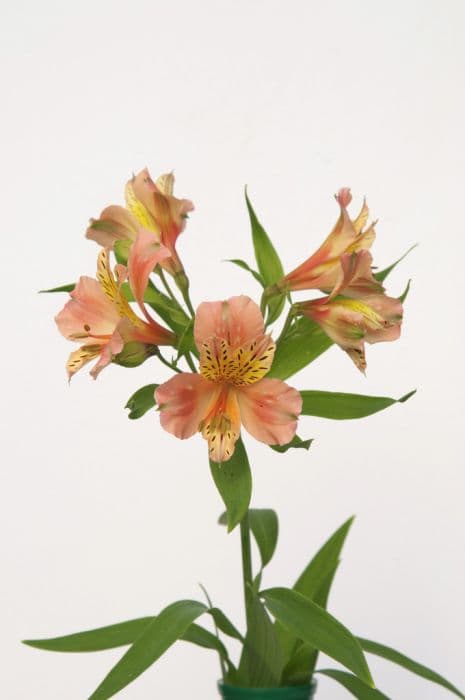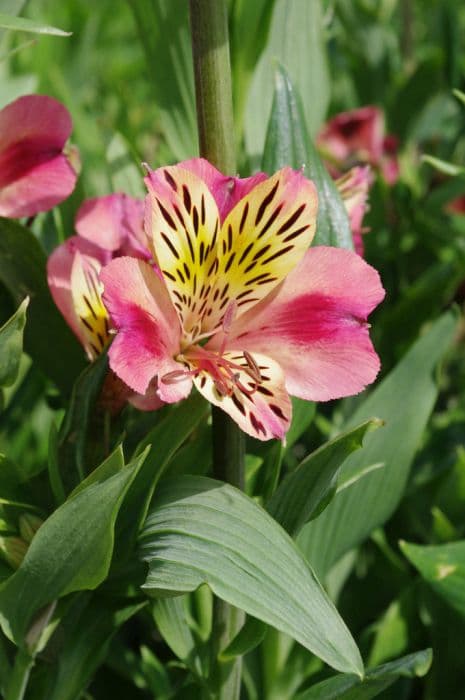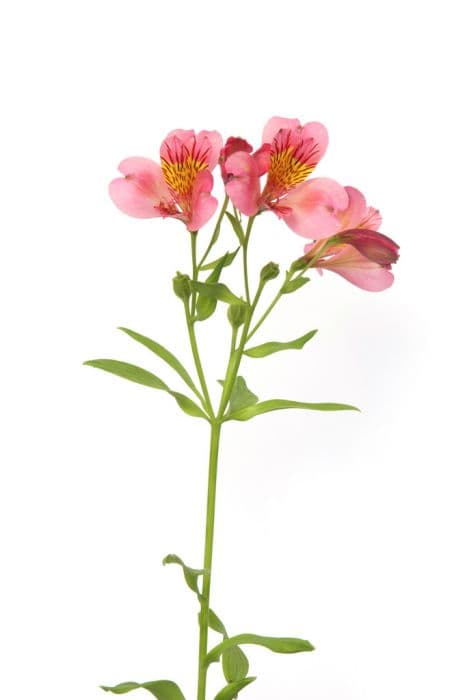Alstroemeria Inticancha Creamy Dark Pink = 'Tescreda' (Inticancha Series)
![Peruvian lily [Inticancha Creamy Dark Pink]](/_next/image?url=https%3A%2F%2Fplants-admin.emdemapps.com%2Fimages%2Fplants%2F%2Fimages%2F604b5e98bea7c.png&w=3840&q=75)
ABOUT
The Alstroemeria Inticancha Creamy Dark Pink, also known as Peruvian Lily from the Inticancha Series, is a striking plant cherished for its ornamental appeal. The plant exhibits lush green foliage that serves as a vibrant backdrop for its standout feature, the exotic blooms. These flowers boast a captivating color palette, blending creamy hues with dark pink shades, resulting in a dramatic contrast that is both eye-catching and elegant. Each blossom of the Peruvian Lily is characterized by a unique pattern; the dark pink speaks in bold strokes along the petal edges, gradually softening as it merges with the creamy center. Additional intrigue is found upon closer observation, where subtle speckles and streaks are typical, offering a depth of complexity to the floral display. The flowers are not solitary but rather grouped in clusters atop sturdy stems, creating a generous bouquet effect that is visually pleasing and perfect for cutting and bringing indoors. This dense floral canopy floats above the greenery, making it a popular choice for gardeners and floral enthusiasts alike, who seek to add a splash of color and exotic texture to their surroundings. Overall, the Peruvian Lily captures the attention with its remarkable colors and detailed flower patterns, making it an enthralling addition to any garden or indoor arrangement, devoid of its specific measurements which are excluded from this description.
About this plant
 Names
NamesFamily
Alstroemeriaceae
Synonyms
Peruvian Lily, Lily of the Incas, Parrot Lily
Common names
Alstroemeria Inticancha Creamy Dark Pink = 'Tescreda' (Inticancha Series).
 Toxicity
ToxicityTo humans
The Alstroemeria, commonly known as the Peruvian Lily or Lily of the Incas, is generally considered non-toxic to humans. However, it's always possible for individuals to have allergic reactions or sensitivity to different plants, so it's wise to handle plants with care and avoid ingestion.
To pets
The Peruvian Lily is mildly toxic to cats and dogs. If a pet ingests this plant, symptoms of poisoning may include mild gastrointestinal upset, such as vomiting or diarrhea. Typically, the toxicity is not severe and serious consequences are rare; however, if a pet consumes a large amount of the plant or exhibits more severe symptoms, it is advisable to consult a veterinarian.
 Characteristics
CharacteristicsLife cycle
Perennials
Foliage type
Evergreen
Color of leaves
Green
Flower color
Pink
Height
1-2 feet (30-60 cm)
Spread
1-2 feet (30-60 cm)
Plant type
Herb
Hardiness zones
7-10
Native area
South America
Benefits
 General Benefits
General Benefits- Vibrant Blossoms: Produces creamy dark pink flowers that add a pop of color to gardens and landscapes.
- Extended Blooming Season: Known for its long blooming period, offering floral display from early summer to late autumn.
- Attracts Pollinators: Its flowers are appealing to bees and butterflies, promoting pollinator activity in the garden.
- Low Maintenance: Requires minimal care once established, making it suitable for busy gardeners and those with limited time.
- Drought Tolerance: Demonstrates a degree of drought resistance which is beneficial for water conservation and low-water gardens.
- Cold Hardy: Capable of withstanding cooler temperatures, making it versatile for a variety of climates.
- Compact Growth: Its mounding habit and moderate growth size make it ideal for containers, borders, and small garden spaces.
- Long-Lasting Cut Flowers: The blooms have an extended vase life, perfect for floral arrangements and bouquets.
- Minimal Pests and Diseases: Generally resistant to pests and diseases, reducing the need for chemical treatments.
- Easy to Propagate: Can be readily propagated through division, allowing gardeners to multiply their plants and share with others.
 Medical Properties
Medical PropertiesThis plant is not used for medical purposes.
 Air-purifying Qualities
Air-purifying QualitiesThis plant is not specifically known for air purifying qualities.
 Other Uses
Other Uses- Ink Production: The dark pink hue of the Peruvian Lily can be used to create natural inks for art and fabric dyeing.
- Photography Prop: Peruvian Lilies make striking subjects or backdrops for photographers, particularly in macro photography due to their intricate patterns.
- Educational Tool: The distinct morphology of the Peruvian Lily can be used to teach botanical concepts such as symmetry, petal arrangement, and pollination.
- Crafts: Dried or pressed Peruvian Lily flowers can be used in scrapbooking, card making, or as part of a dried flower arrangement for home decor.
- Theme Gardens: Peruvian Lilies can be included in garden designs centered around South American plants or high-altitude flora to represent their native habitat.
- Culinary Garnish: Though not commonly consumed, the flowers can be used as edible decorations on cakes and desserts after ensuring they are free of pesticides.
- Fragrance Collection: The mild scent of Peruvian Lilies can be captured and used in creating subtly scented candles or potpourri.
- Seed Harvesting: Garden enthusiasts can collect seeds from the Peruvian Lily to propagate new plants or experiment with hybridization.
- Children's Games: The sturdy stems and blooms can be used by children to create natural fairy wands or for imaginative play in gardens.
- Art Installations: The vibrant color and form of Peruvian Lily can inspire or be incorporated into large-scale art installations or floral displays.
Interesting Facts
 Feng Shui
Feng ShuiThe plant_name is not used in Feng Shui practice.
 Zodiac Sign Compitability
Zodiac Sign CompitabilityThe Peruvian Lily is not used in astrology practice.
 Plant Symbolism
Plant Symbolism- Friendship: Alstroemeria, also known as Peruvian Lily or Lily of the Incas, often symbolizes strong bonds of friendship, due to its twining leaves which represent the interwoven nature of relationships.
- Devotion: The multiple, vibrant flowers of the Alstroemeria signify the recipient's worthiness and the giver's devotion.
- Wealth and Prosperity: With its full clusters of flowers, the Alstroemeria is frequently associated with wealth, abundance, and prosperity.
- Good Fortune: The Peruvian Lily is often given as a gesture to wish someone luck and happiness in their future endeavors.
 Water
WaterPrincess lilies require regular watering to maintain moist soil, particularly during the growing season in spring and summer. It's usually best to water them once or twice a week, depending on weather conditions. Always check the top inch of the soil for dryness before watering. When you do water, aim to provide enough water to soak the soil thoroughly, which might be around 1 to 1.5 gallons for an outdoor plant or 16-24 ounces for a potted plant. Reduce watering frequency in the fall and winter when the plant is not actively growing.
 Light
LightPrincess lilies thrive in bright, indirect sunlight. They can tolerate some direct morning light but should be protected from the harsh afternoon sun. The ideal spot for these plants is in an east-facing garden where they receive gentle morning sunlight or a partially shaded area that gets filtered light throughout the day.
 Temperature
TemperaturePrincess lilies prefer temperatures ranging between 65 and 80 degrees Fahrenheit during the day and should not be exposed to temperatures below 50 degrees Fahrenheit, as cold temperatures can damage the plant. Though they can survive temporary dips in temperature, prolonged exposure to cold can be detrimental. The ideal temperature range will promote healthy growth and flowering.
 Pruning
PruningPrincess lilies benefit from occasional pruning to remove dead or fading flowers and leaves, which encourages new blooms and maintains plant health. Prune in early spring or after the plant has finished flowering to shape it and stimulate new growth. Deadheading spent flowers throughout the growing season can also promote further blooming.
 Cleaning
CleaningAs needed
 Soil
SoilThe Princess Lily requires well-draining soil with a mix of potting soil, peat, and perlite to ensure proper drainage and aeration. Soil pH should be slightly acidic to neutral, around 6.0 to 7.0.
 Repotting
RepottingPrincess Lilies should be repotted every two to three years, or when the root system outgrows the container, to provide fresh nutrients and space for continued growth.
 Humidity & Misting
Humidity & MistingPrincess Lilies thrive in moderate humidity levels around 40-60%. Avoid excessively dry air which can cause leaf tips to brown.
 Suitable locations
Suitable locationsIndoor
Place in bright, indirect light and monitor soil moisture.
Outdoor
Grow in partial sun, sheltered from intense heat.
Hardiness zone
7-10 USDA.
 Life cycle
Life cycleThe life of an Alstroemeria, commonly known as Peruvian Lily or Lily of the Incas, begins with seed germination, which requires warm temperatures and can take a few weeks. Following germination, the seedling grows into a juvenile plant, developing a strong root system and foliage. As the plant matures, it forms a clump with multiple stems and leaves, entering the vegetative growth stage. Once mature, the Alstroemeria Inticancha Creamy Dark Pink produces numerous trumpet-shaped, creamy dark pink flowers, typically in late spring or early summer, entering the reproductive stage. After pollination and flowering, seed pods may form, and once they dry, they split open to release seeds for the next generation. Finally, the plant enters a period of dormancy in winter, conserving energy and resources to survive colder temperatures before re-emerging in the spring.
 Propogation
PropogationPropogation time
Spring-Early Summer
The most popular method of propagating the Alstroemeria, also known as Peruvian Lily or Lily of the Incas, is by division of its rhizomes. This is typically done in the spring when the plant has emerged from dormancy and is beginning to show signs of growth. To propagate, carefully dig up the plant, making sure to retain as much of the root system as possible. Then, gently separate the rhizomes by hand, ensuring that each division has at least one or two growth points or 'eyes'. These divisions can then be replanted immediately, keeping them at the same soil depth they were previously growing. It's essential to keep the new divisions well-watered until they are established, which helps to enhance root development and plant establishment.




![Peruvian lily [Indian summer]](/_next/image?url=https%3A%2F%2Fplants-admin.emdemapps.com%2Fimages%2Fplants%2F%2Fimages%2F604b616bc746b.png&w=640&q=75)
![Peruvian lily [Inticancha Imala]](/_next/image?url=https%3A%2F%2Fplants-admin.emdemapps.com%2Fimages%2Fplants%2F%2Fimages%2F604b619b522ba.png&w=640&q=75)
![Peruvian lily [Inticancha Red]](/_next/image?url=https%3A%2F%2Fplants-admin.emdemapps.com%2Fimages%2Fplants%2F%2Fimages%2F604b5aebac273.png&w=640&q=75)
![Peruvian lily [Inticancha Sunday]](/_next/image?url=https%3A%2F%2Fplants-admin.emdemapps.com%2Fimages%2Fplants%2F%2Fimages%2F604b646146dd9.png&w=640&q=75)

